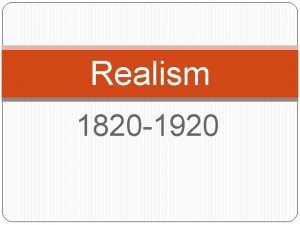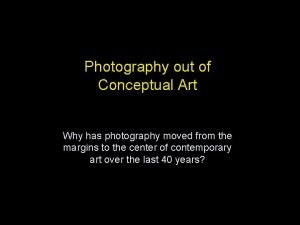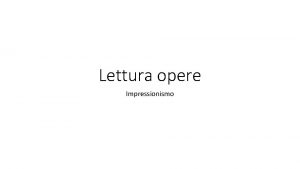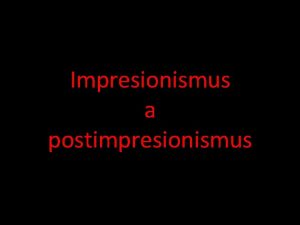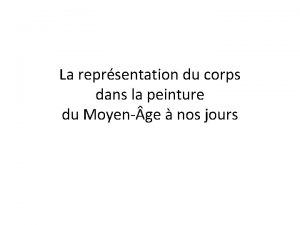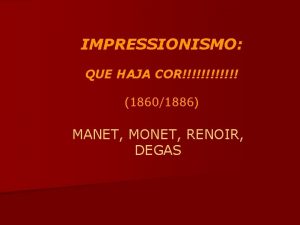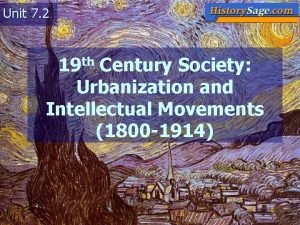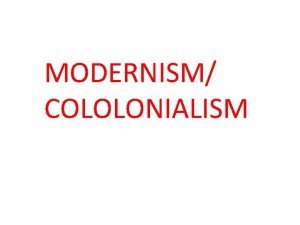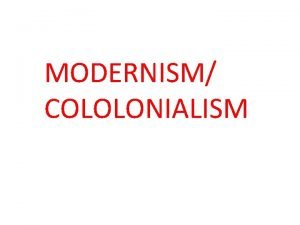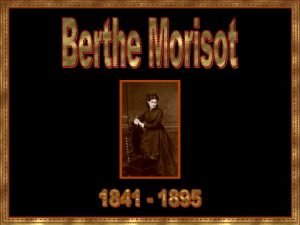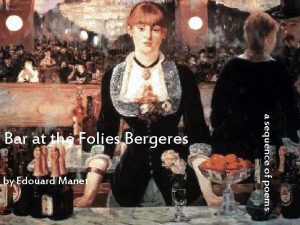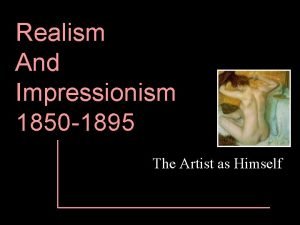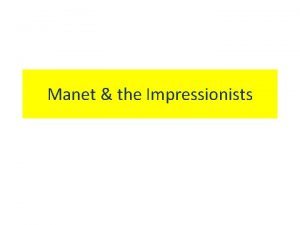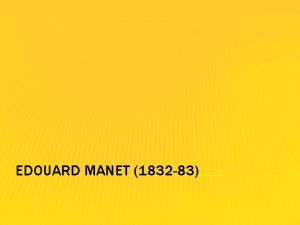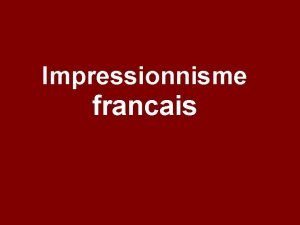Manet What was the name of the accepted































- Slides: 31

Manet

What was the name of the accepted type of art in France at the time that Manet was starting out as a painter?

Classical art or Classicism

Definition of Classicism can be defined as the type of art promoted by, and displaying the values of the French ‘Academie des Beaux Art’. This type of art was concerned with idealised beauty. The subject matter was of historical, biblical and mythological scenes. These were painted with great drama and portrayed the characters (people) as objects of perfection (for the time) both physically and morally.

Delacroix – liberty leading the People 1830

Composition in Classical paintings was generally central with all the characters and activity happening in the middle of the painting. The brushwork was mostly smooth and highly polished. These paintings used a lot of contrast in their colour and lighting, contrasting blacks browns and greys with whites and creams.

Oedipus & the Sphinx by Ingres Death of a Marat by David

Manet • Manet is often considered a Realist…. • However he is more famously known as ‘the Father of Impressionism’.

Early career • Manet trained as a painter through the official system of the Ecoles des Beaux Arts. • He learned his craft in the studio of Thomas Couture and spent 6 years there as an apprentice painter.

Déjeuner sur l’Herbe 1863

• This painting was rejected by the Salon in 1863, but it was exhibited in the ‘Salon des Refuses’ where it caused controversy as a result of it’s subject matter.

The Salon des Refusés • The ‘Salon des Refusés’ was an exhibition set up by Emperor Napoleon III to run alongside the annual official Salon exhibition. It only ran in 1863. this was due to the large amount of artists whose paintings were refused to the Salon that year. The artists complained to the Emperor (France’s ruler) and he went to see the paintings. As he couldn’t tell the difference between the paintings selected for the Salon exhibition and those rejected, he declared that all rejected painting be exhibited a second parallel exhibition in the Lourve – the ‘Salon des Refusés’.


Déjeuner sur l’Herbe • The Salon jury was outraged by this painting as it didn’t follow the rules of Classical art. • Although nudes were common in paintings at the time, Manet decided to paint a contemporary scene instead of a historical/biblical/mythological scene. • His subject matter was of artists and their models taking a lunch break from painting ‘en plein air’ in the forest of Fountainbleu on the outskirts of Paris. • This was unacceptable to the Salon as his female model was shown exactly as she was; not improved on or made to look like what was considered perfect in art at the time.

• Manet’s brushwork did not conform to the Academy’s standards either. Rather than smooth and polished, we can see evidence of Manet’s brush marks and some areas were not fully blended. • Manet also plays with the perspective. The woman in the background appears to be floating, so he isn’t following the rules of linear perspective. He does this on purpose as he wants her to be as important as the other parts of the painting but the Academy don’t understand this.

Symbolism in ‘Déjeuner’ • This contemporary subject matter was full of symbols that the Academy and the public would have easily understood, which made the painting so controversial at the time. • The overturned basket was a symbol of the loss of innocence; fruit such as peaches, figs and cherries were symbols of carnal activity and the empty oyster shells and suggest that these women may have had two jobs – one as a model, but a second job as a prostitute or the lovers of the artists. The small frog in the corner of the painting confirms this. The French word frog ‘grenouille’ was also a slang word for prostitute.

Artist’s Models at that time It was common at this time for artist’s models to be prostitutes also, as it was unacceptable for women of high classes to be alone with men. So often the only women available to paint would have been those who worked in bars or as prostitutes. Not all bar workers or models worked as prostitutes however.

Although many upper class men would have had a mistress at this time. It was seen as acceptable but never spoken about. What made Manet’s painting so shocking to the Paris socialites was that he was making public, something that had always been private. As many women would have accompanied their husbands to the exhibition, this painting would have caused great embarrassment to many of these men and brought the subject of adultery out in the open.

Manet’s favourite model • Manet used the same model for both of the women in ‘Déjeuner’. Her name is Victorine Meurent. She was one of his favourite models. Manet like to paint her because she had a real face, not one that seemed fake or idealised like the ones in so many Classical paintings at that time. He said that in her face he found ‘truth’. • Meurent was also an artist in her own right.


Comparisions with Manet & Titian • The composition and narrative of ‘Déjeuner’ is influenced by Titian’s ‘Concert Champêtre’. • Manet was very influenced by earlier art work and Classical art also. He wanted to show these tradition ways of working could be updated for the modern world.


• Manet wanted to change the institution of the academy, not get rid of it. He wanted to change it from the inside out, that’s why he never stopped submitting paintings to the salon for selecting. • It really annoyed him that he was rejected so many times.

Olympia

Titian – ‘Venus of Urbino’

clip • Tim Marlow DVD • 6. 47 Dejeuner • 8. 20 Olympia

Manet becomes more Impressionistic • Manet’s work inspires a group of younger artists later to be know as the Impressionists. • Monet and Manet are influenced by each other’s work. In a series of paintings created in Argenteuil with Monet and his family, we see Manet produce very Impressionistic paintings.

Manet ‘Monet working on his boat’ 1874 Monet ‘Regatta at Argenteuil’

Manet ‘The Monet Family in their Garden in Argenteuil’ 1874 Monet ‘The Bridge at Argenteuil’ 1874

Clip – The impressionists Monet, Manet 29. 77

The Bar at the Folies-Bergere 1882
 Name
Name Edourad manet
Edourad manet Conceptual art photography
Conceptual art photography Keknanet
Keknanet Ballo al moulin de la galette analisi
Ballo al moulin de la galette analisi Olympie manet
Olympie manet Properties of manet
Properties of manet Manet, olympia, 1863
Manet, olympia, 1863 Manet meaning
Manet meaning Manet, olympia, 1863
Manet, olympia, 1863 Manet e renoir
Manet e renoir Impressionism 1867 to 1886
Impressionism 1867 to 1886 Kek manet
Kek manet The stonebreakers
The stonebreakers Olympia gauguin
Olympia gauguin Edouard manet olympia 1863
Edouard manet olympia 1863 Berthe morisot con un ramo de violetas
Berthe morisot con un ramo de violetas La prugna manet
La prugna manet Edouard manet olympia 1863
Edouard manet olympia 1863 Edouard manet two bottles of bass
Edouard manet two bottles of bass Manet paintings
Manet paintings Monet nationality
Monet nationality Islamic interbank money market
Islamic interbank money market 202 accepted
202 accepted Islamic accepted bills
Islamic accepted bills Internationally accepted rights of the children
Internationally accepted rights of the children Congratulations you have been accepted
Congratulations you have been accepted Dalton's atomic theory was accepted because
Dalton's atomic theory was accepted because Internationally accepted rights of the child
Internationally accepted rights of the child Im accepted i'm forgiven
Im accepted i'm forgiven The commonly accepted goal of the mnc is to:
The commonly accepted goal of the mnc is to: Deindividuation
Deindividuation

